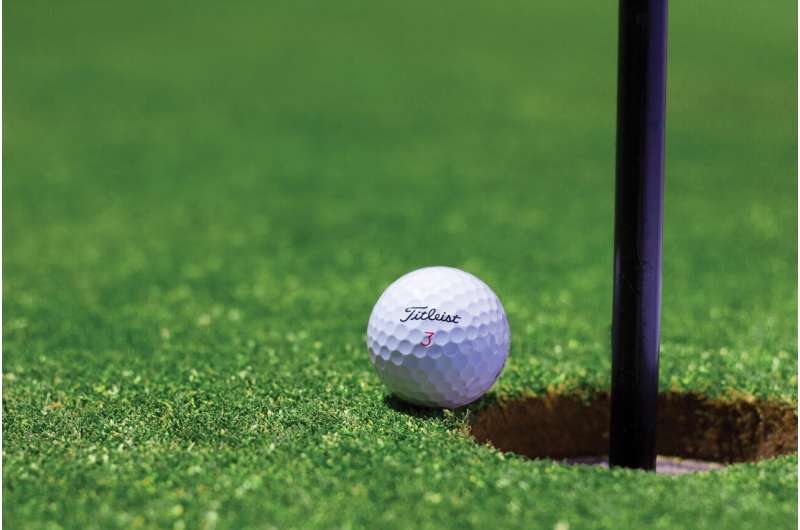Science
Researchers Uncover Physics Behind Golf’s Frustrating ‘Lip Out’

In an intriguing intersection of sports and physics, researchers at the University of Bristol have conducted a study revealing the mechanics behind the frustrating “lip out” phenomenon in golf. This occurrence, where a putted ball hits the rim of the hole but fails to drop in, has baffled both amateur and professional golfers alike. The findings, published on November 4, 2025, in the journal Royal Society Open Science, delve into the forces at play during this common yet perplexing moment in the game.
Emeritus Professor John Hogan, who led the research, applied principles of mechanics to explore why golf balls can sometimes defy expectations at the crucial moment. He humorously referred to these elusive shots as “the golf balls of death,” likening their behavior to the daring circular stunt performed by motorcycle riders known as the “wall of death.”
The research identifies two distinct types of lip outs: the rim lip out and the hole lip out. The rim lip out occurs when the center of mass of the ball does not descend below the level of the green, while the hole lip out happens under specific conditions when the ball enters the hole but does not settle within it. “We considered the motion from the point of view of mechanics,” Professor Hogan explained, noting that the dynamics on the rim of the hole create a precarious balance.
At the core of both phenomena lies a concept known as “degenerate saddle equilibria.” This describes the state where a golf ball precariously balances on the edge of the hole, caught between falling in and rolling back out. The rim lip out involves the ball rotating around the hole at a fixed angle and velocity, making it susceptible to perturbations such as wind or even minor imperfections on the green.
In contrast, the hole lip out occurs when the ball rolls into the hole and begins a pendulum-like motion. “Here, the golf ball falls into the hole, where it undergoes a pendulum-like motion, as it rolls around the wall of the hole,” Professor Hogan elaborated. He noted that this motion converts potential energy into spin, which can result in the ball escaping back to the rim rather than settling at the bottom.
For golfers looking to reduce the likelihood of experiencing a lip out, Professor Hogan recommends aiming as closely as possible to the center of the hole. He emphasizes the importance of arriving at the rim with minimal speed, suggesting that this combination allows just enough momentum for the ball to tip into the hole without rolling back out.
This research extends Professor Hogan’s exploration of mechanics in sports, which has included previous studies on the physics of skateboarding and the trajectory of basketballs. By applying Sir Isaac Newton‘s Laws of Motion to these sporting scenarios, Hogan’s work enriches our understanding of the physical principles governing athletic performance.
As golfers continue to grapple with the nuances of putting, this research provides valuable insights that may help players adjust their techniques and strategies on the green. The findings highlight not only the complexities of the game but also the fascinating interplay between physics and sports performance.
For further details on this study, refer to the publication in Royal Society Open Science under the title “Mechanics of the golf lip out,” DOI: 10.1098/rsos.250907.
-

 Science3 weeks ago
Science3 weeks agoIROS 2025 to Showcase Cutting-Edge Robotics Innovations in China
-

 World3 weeks ago
World3 weeks agoBravo Company Veterans Honored with Bronze Medals After 56 Years
-

 Politics3 weeks ago
Politics3 weeks agoJudge Considers Dismissal of Chelsea Housing Case Citing AI Flaws
-

 Lifestyle3 weeks ago
Lifestyle3 weeks agoStone Island’s Logo Worn by Extremists Sparks Brand Dilemma
-

 Health3 weeks ago
Health3 weeks agoStartup Liberate Bio Secures $31 Million for Next-Gen Therapies
-

 Top Stories3 weeks ago
Top Stories3 weeks agoIndonesia Suspends 27,000 Bank Accounts in Online Gambling Crackdown
-

 Health3 weeks ago
Health3 weeks agoTop Hyaluronic Acid Serums for Radiant Skin in 2025
-

 Sports3 weeks ago
Sports3 weeks agoMel Kiper Jr. Reveals Top 25 Prospects for 2026 NFL Draft
-

 World3 weeks ago
World3 weeks agoHoneywell Predicts Record Demand for Business Jets Over Next Decade
-

 Lifestyle3 weeks ago
Lifestyle3 weeks agoMary Morgan Jackson Crowned Little Miss National Peanut Festival 2025
-

 Sports3 weeks ago
Sports3 weeks agoYamamoto’s Mastery Leads Dodgers to 5-1 Victory in NLCS Game 2
-

 Science3 weeks ago
Science3 weeks agoArizona State University Transforms Programming Education Approach







